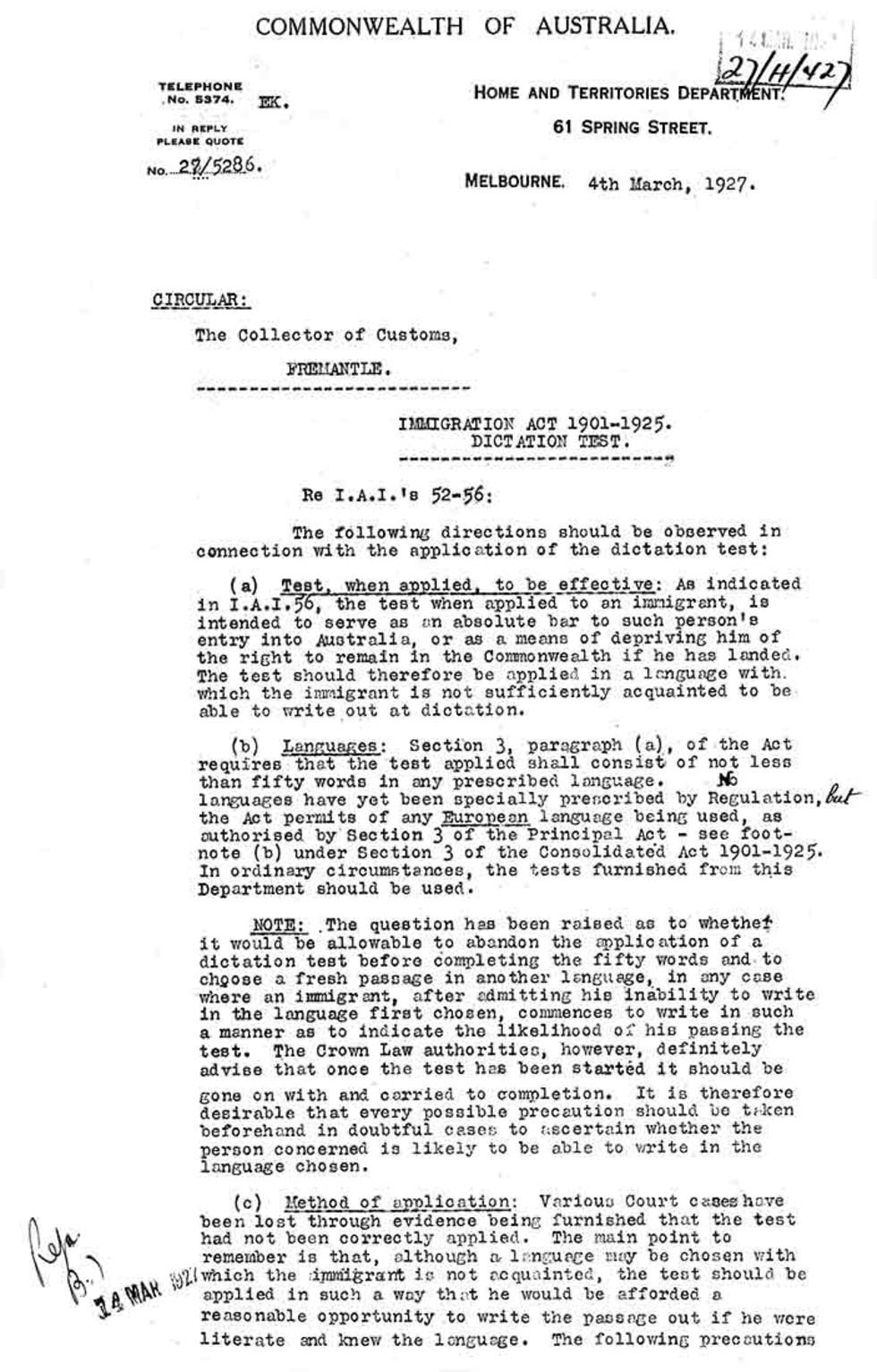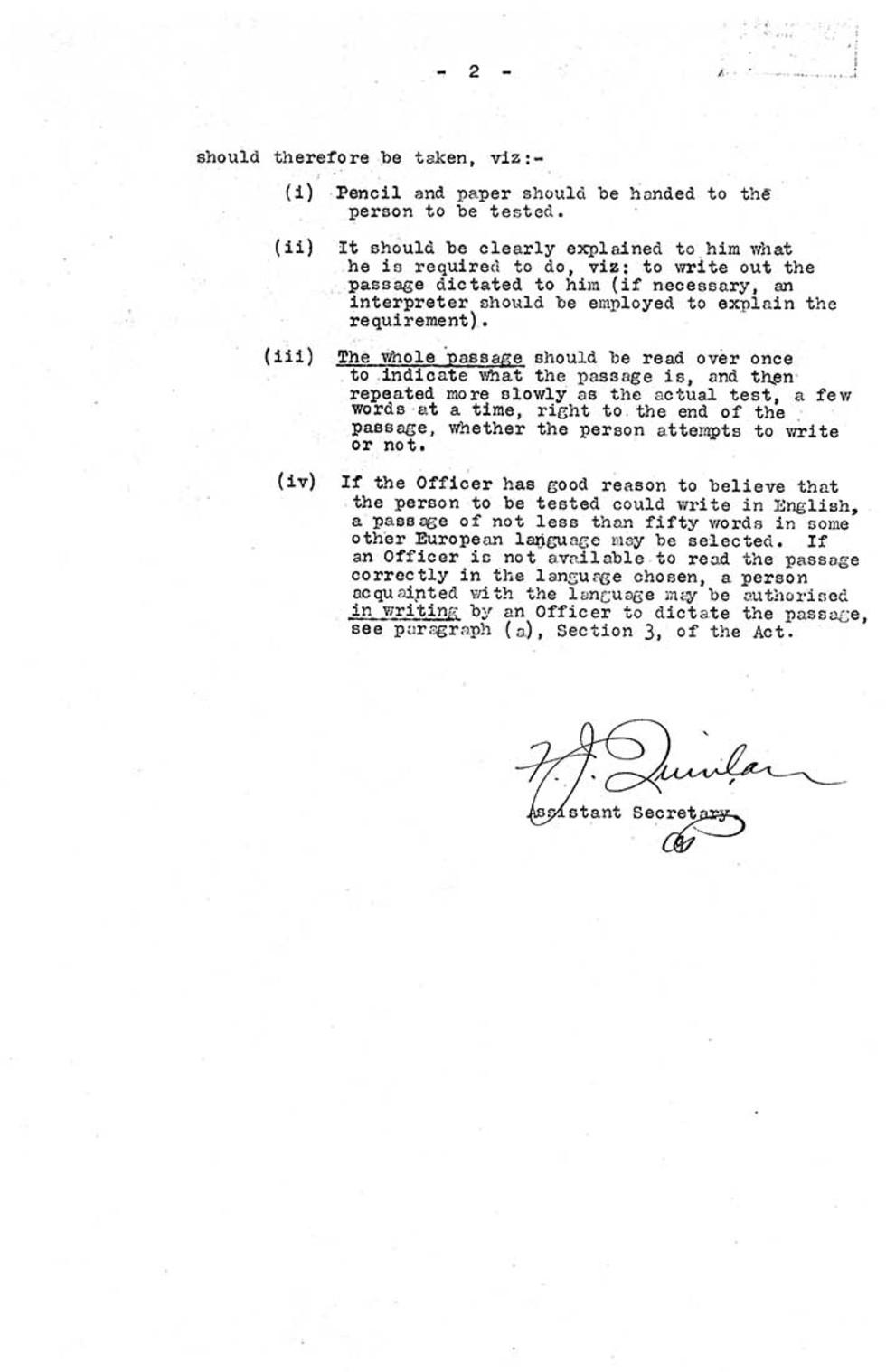
Circular to the Collector of Customs, Fremantle.

Circular to the Collector of Customs, Fremantle.
Aboriginal and Torres Strait Islander people should be aware that the National Archives' website and collection contain the names, images and voices of people who have died.
Some records include terms and views that are not appropriate today. They reflect the period in which they were created and are not the views of the National Archives.


Circular to the Collector of Customs, Fremantle.

Circular to the Collector of Customs, Fremantle.
COMMONWEALTH OF AUSTRALIA.
HOME AND TERRITORIES DEPARTMENT.
61 SPRING STREET.
MELBOURNE. 4th March, 1927.
TELEPHONE
No. 5374. EK.
IN REPLY PLEASE QUOTE
No. 27/5286
CIRCULAR:
The Collector of Customs,
FREMANTLE.
IMMIGRATION ACT 1901–1925.
DICTATION TEST.
Re I.A.I.’s 52-56:
The following directions should be observed in connection with the application of the dictation test:
(a) Test, when applied, to be effective: As indicated in I.A.I.56, the test when applied to an immigrant, is intended to serve as an absolute bar to such person’s entry into Australia, or as a means of depriving him of the right to remain in the Commonwealth if he has landed. The test should therefore be applied in a language with which the immigrant is not sufficiently acquainted to be able to write out at dictation.
(b) Languages: Section 3, paragraph (a), of the Act requires that the test applied shall consist of not less than fifty words in any prescribed language. No languages have yet been specially prescribed by Regulation, But the Act permits of any European language being used, as authorised by Section 3 of the Principal Act—see footnote (b) under Section 3 of the Consolidated Act 1901–1925. In ordinary circumstances, the tests furnished from this Department should be used.
NOTE: The question has been raised as to whether it would be allowable to abandon the application of a dictation test before completing the fifty words and to choose a fresh passage in another language, in any case where an immigrant, after admitting inability to write in the language first chosen, commences to write in such a manner as to indicate the likelihood of his passing the test. The Crown Law authorities, however, definitely advise that once the test has been started it should be gone on with and carried to completion. It is therefore desirable that every possible precaution should be taken beforehand in doubtful cases to ascertain whether the person concerned is likely to be able to write in the language chosen.
(c) Method of application: Various Court cases have been lost through evidence being furnished that the test had not been correctly applied. The main point to remember is that, although a language may be chosen with which the immigrant is not acquainted, the test should be applied in such a way that he would be afforded a reasonable opportunity to write the passage out if he were literate and knew the language. The following precautions should therefore be taken, viz:–
(i) Pencil and paper should be handed to the person to be tested.
(ii) It should be clearly explained to him what he is required to do, viz.: to write out the passage dictated to him (if necessary, an interpreter should be employed to explain the requirement).
(iii) The whole passage should be read over once to indicate what the passage is, and then repeated more slowly as the actual test, a few words at a time, right to the end of the passage, whether the person attempts to write or not.
(iv) If the Officer has good reason to believe that the person to be tested could write in English, a passage of not less than fifty words in some other European language may be selected. If an Officer is not available to read the passage correctly in the language chosen, a person acquainted with the language may be authorised in writing by an Officer to dictate the passage, see paragraph (a), Section 3, of the Act.
F. J. Quinlan
Assistant Secretary
This is a circular (a written statement explaining government policy) from FJ Quinlan, Assistant Secretary of the Australian Government’s Department of Home and Territories, to the Collector of Customs in Fremantle, Western Australia. It gives detailed directions on how to apply the Immigration Restriction Act’s dictation test.
Learning resource text © Education Services Australia Limited and the National Archives of Australia 2010.
Learn how to interpret primary sources, use our collection and more.
